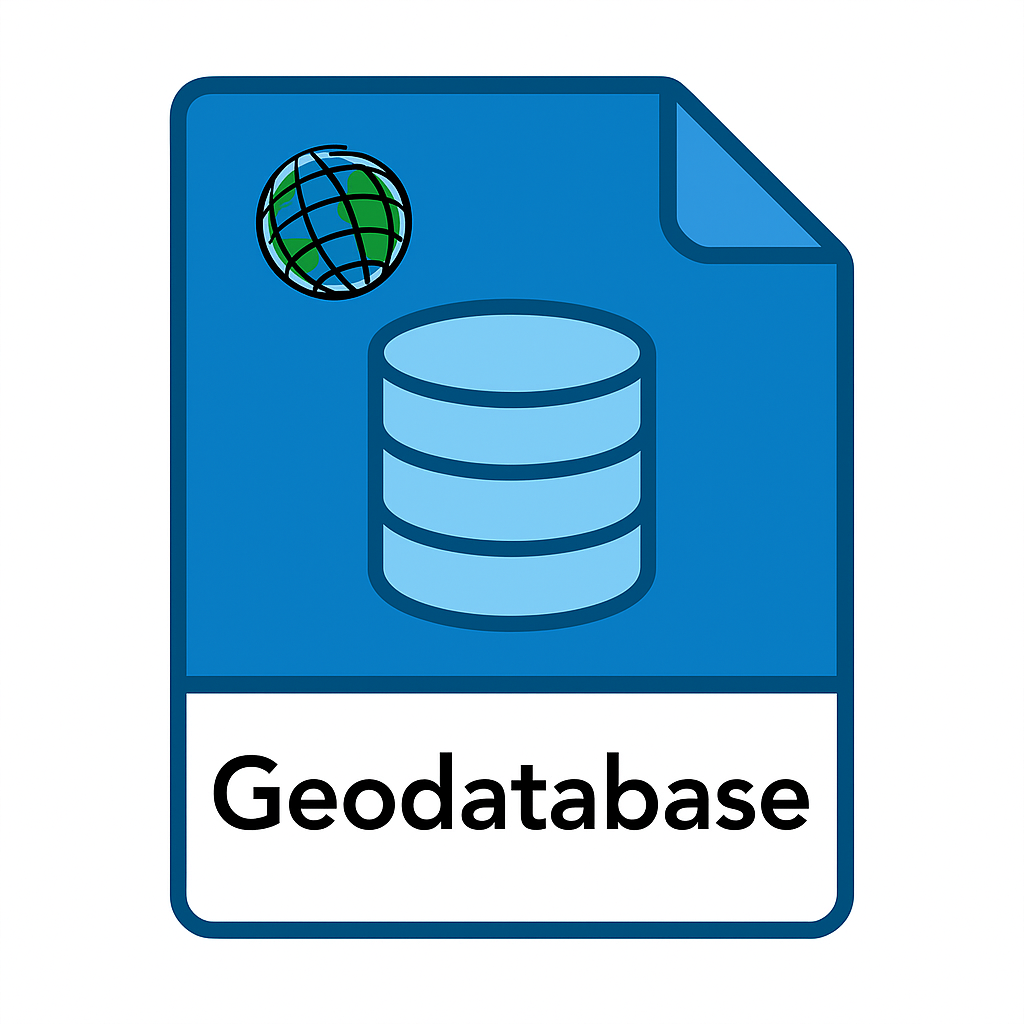Part 2 of a 6 part series on the geodatabase data format. You can read Part 1 here.
The geodatabase architecture in ArcGIS Pro encompasses three distinct implementation types, each designed to serve specific use cases and deployment scenarios. Understanding the capabilities, limitations, and optimal applications of File Geodatabases, Enterprise Geodatabases, and Mobile Geodatabases is crucial for designing effective spatial data management strategies.
File Geodatabase: The Desktop Powerhouse
The File Geodatabase represents the most commonly used geodatabase implementation, designed primarily for individual users and small teams working on desktop GIS applications. Stored as a collection of files within a folder structure, the File Geodatabase provides robust capabilities while maintaining simplicity and portability.
Architecture and Storage File Geodatabases are implemented as a collection of binary files within a folder with a .gdb extension. This architecture enables efficient storage and retrieval while maintaining the ability to copy, move, and backup geodatabases using standard file system operations. Each dataset within the geodatabase is stored as a separate file, allowing for granular access and efficient space utilization.
The storage architecture employs sophisticated compression algorithms that can reduce storage requirements by up to 70% compared to equivalent shapefile datasets. This compression is transparent to users and applications, providing significant storage efficiency without sacrificing performance or functionality.
Capacity and Performance File Geodatabases support individual datasets up to 1 terabyte in size, with no practical limit on the number of datasets within a single geodatabase. This represents a massive improvement over shapefile limitations and enables the storage of extremely large spatial datasets within a single container.
Performance optimizations include automatic spatial indexing, efficient query processing, and optimized storage structures that provide rapid access to spatial data. For most desktop applications, File Geodatabases deliver superior performance compared to file-based alternatives, particularly for complex queries and spatial analysis operations.
Collaboration and Sharing While File Geodatabases are primarily designed for single-user applications, they support several collaboration mechanisms. Geodatabases can be easily shared through file systems, cloud storage, or removable media. For more sophisticated collaboration, File Geodatabases support geodatabase replication, enabling synchronized editing across multiple copies of the same data.
The geodatabase also supports export and import operations that enable data exchange with other ArcGIS implementations. This includes packaging capabilities that bundle geodatabase contents with associated metadata, symbology, and documentation for comprehensive data sharing.
Limitations and Considerations File Geodatabases do not support simultaneous multi-user editing of the same datasets. While multiple users can access a File Geodatabase for read-only operations, editing requires exclusive access to individual feature classes. This limitation makes File Geodatabases less suitable for enterprise applications requiring concurrent editing by multiple users.
Additionally, File Geodatabases lack some advanced features available in Enterprise Geodatabases, including traditional versioning, sophisticated user management, and enterprise-scale performance optimizations.
Enterprise Geodatabase: Multi-User and Enterprise Scale
Enterprise Geodatabases represent the most sophisticated implementation of the geodatabase data model, designed for multi-user environments and enterprise-scale applications. Built on commercial database management systems including SQL Server, Oracle, PostgreSQL, and IBM Db2, Enterprise Geodatabases provide industrial-strength capabilities for demanding applications.
Database Platform Integration Enterprise Geodatabases leverage the robust capabilities of commercial database systems while adding spatial data management capabilities. This integration provides enterprise-grade features including advanced security, sophisticated backup and recovery, replication, and performance optimization. Organizations can leverage existing database administration expertise and infrastructure while gaining advanced spatial data capabilities.
The geodatabase engine implements spatial indexing, query optimization, and data management functions as extensions to the underlying database system. This approach ensures that spatial data benefits from the same reliability, performance, and management capabilities as traditional enterprise data.
Versioning and Multi-User Editing One of the most significant advantages of Enterprise Geodatabases is support for sophisticated versioning mechanisms that enable simultaneous editing by multiple users. The versioning system maintains multiple representations of the same data, allowing users to make changes without interfering with each other’s work.
Traditional versioning maintains a complete historical record of all changes, enabling long transaction support, conflict detection and resolution, and historical analysis of data changes. This capability is essential for enterprise workflows involving multiple editors, complex approval processes, and audit trail requirements.
Branch versioning, introduced in recent ArcGIS versions, provides a more efficient versioning mechanism optimized for modern editing workflows. Branch versioning reduces storage overhead while maintaining the multi-user editing capabilities essential for enterprise applications.
Advanced Security and Administration Enterprise Geodatabases implement sophisticated security models that integrate with enterprise authentication systems. Database-level security controls access to individual datasets, while geodatabase-specific security manages spatial data operations and editing privileges.
Administrative capabilities include comprehensive logging, performance monitoring, and maintenance operations that ensure reliable operation in demanding environments. Database administrators can implement backup strategies, performance tuning, and capacity planning using standard database administration tools and procedures.
Scalability and Performance Enterprise Geodatabases are designed to scale to support thousands of concurrent users and terabytes of spatial data. Performance optimizations include advanced caching, query optimization, and distributed processing capabilities that maintain responsiveness under heavy load.
The integration with commercial database systems enables leveraging enterprise database features including clustering, replication, and load balancing that provide high availability and disaster recovery capabilities essential for mission-critical applications.
Enterprise Integration Enterprise Geodatabases integrate seamlessly with enterprise IT infrastructure and workflows. This includes integration with enterprise backup systems, monitoring tools, and change management processes. The geodatabase can participate in enterprise data governance and compliance frameworks while providing specialized spatial data capabilities.
Mobile Geodatabase: Field Data Collection
Mobile Geodatabases are specialized implementations designed for offline field data collection and mobile GIS applications. These geodatabases enable robust spatial data management on mobile devices while supporting synchronization with enterprise data sources.
Offline Capabilities Mobile Geodatabases are specifically designed to operate without network connectivity, enabling field data collection in remote locations. They support the complete range of geodatabase capabilities including complex data models, topology validation, and advanced field types while operating entirely offline.
The offline architecture ensures data integrity and consistency even when operating without network connectivity for extended periods. When connectivity is restored, sophisticated synchronization mechanisms ensure that field edits are properly integrated with enterprise data sources.
Synchronization and Conflict Resolution Mobile Geodatabases implement sophisticated synchronization capabilities that enable seamless integration with File and Enterprise Geodatabases. Synchronization can be performed manually or automatically when network connectivity is available.
Conflict resolution mechanisms handle situations where the same features have been edited both in the field and in the office. These mechanisms provide options for automated resolution based on predefined rules or manual resolution by users with appropriate privileges.
Platform Integration Mobile Geodatabases are optimized for mobile device capabilities and constraints including limited storage, processing power, and battery life. The implementation provides efficient data access while minimizing resource consumption to preserve device performance and battery life.
Integration with mobile device capabilities includes support for GPS positioning, camera integration for photo attachments, and touch-optimized editing interfaces that provide efficient data collection workflows.
Choosing the Right Geodatabase Type
File Geodatabase is optimal for:
- Individual users and small teams
- Desktop-focused workflows
- Projects requiring data portability
- Applications where multi-user editing is not required
- Rapid prototyping and development
Enterprise Geodatabase is essential for:
- Multi-user editing environments
- Enterprise-scale applications
- Applications requiring sophisticated security
- Workflows involving complex approval processes
- Integration with enterprise IT infrastructure
Mobile Geodatabase is designed for:
- Field data collection applications
- Offline editing requirements
- Mobile device deployment
- Integration with enterprise data sources
- Disconnected editing workflows
Hybrid Deployment Strategies
Many organizations implement hybrid strategies that leverage multiple geodatabase types within integrated workflows. For example, an organization might maintain authoritative data in an Enterprise Geodatabase while using File Geodatabases for analysis projects and Mobile Geodatabases for field data collection.
These hybrid approaches enable organizations to optimize for different use cases while maintaining data consistency and integration across the enterprise. Geodatabase replication and synchronization capabilities ensure that data flows seamlessly between different geodatabase implementations.
Conclusion
Understanding the capabilities and appropriate applications of different geodatabase types is essential for implementing effective spatial data management strategies. Each geodatabase type offers distinct advantages that make it optimal for specific use cases and deployment scenarios.
The choice between geodatabase types should be based on careful analysis of user requirements, technical constraints, and organizational capabilities. In many cases, organizations benefit from implementing multiple geodatabase types within integrated workflows that leverage the strengths of each implementation.
This is Part 2 of our comprehensive series on the geodatabase format in ArcGIS Pro. In the next article, we’ll explore geodatabase data models and schema design principles.

